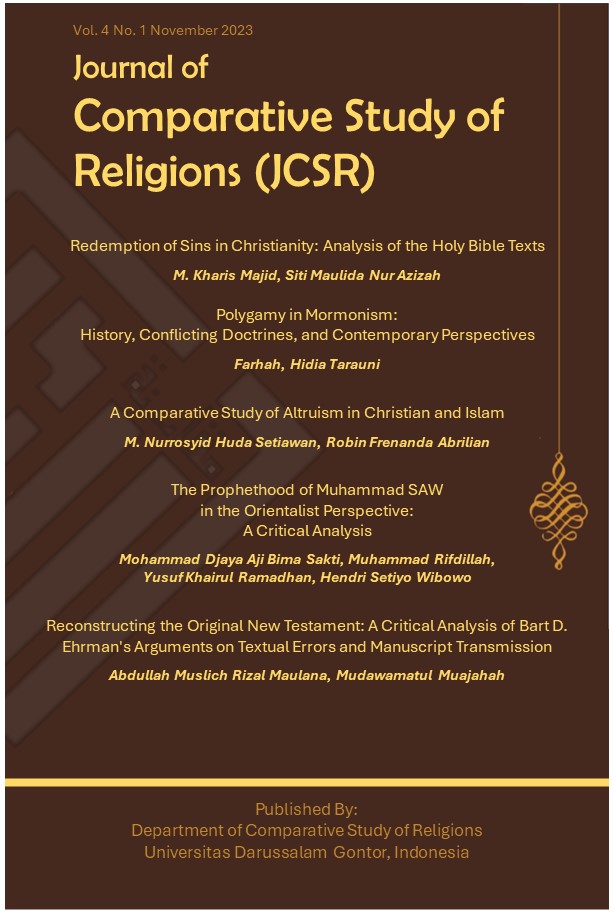Reconstructing the Original New Testament: A Critical Analysis of Bart D. Ehrman's Arguments on Textual Errors and Manuscript Transmission
DOI:
https://doi.org/10.21111/jcsr.v4i01.8949Keywords:
Authenticity, Bart D. Ehrman, New Testament,Abstract
This study aimed to discuss the thought of Bart D. Ehrman, an American New Testament Scholar, regarding this idea of the contradiction in his research into the New Testament in many of his books, which was considered controversial and initiated a heated debate among theologians and other scholars. This research employed a library research method by analyzing various written sources such as books, articles, and scientific journals that discuss Bart D. Ehrman's thoughts on the contradictions in the New Testament. The nature of this research is qualitative, where the researcher analyzes and interprets textual data to understand Ehrman's thoughts and their implications for New Testament studies. Ehrman affirmed that since its initial copying process, the Bible had been using the hand-copying method, resulting in many errors in the manuscript. Up to the number of copyists who copy back the wrong copy and make new mistakes; eventually, many copies of the New Testament exist today, but none of these copies are known to be copies of the original book, nor copies of the first copies. Instead, they are copies of copies of other copies that have been scattered long after the original writing period. Which undoubtedly contains very many errors and differences in each copy. Mistakes that arise because they are intentional or unintentional. This study concluded that, according to Ehrman, it has been very tough to reconstruct the original text of the New Testament. Nevertheless, even so, he still stated that it was a big mistake deciding to stop learning the texts of the New Testament.References
The Holy Bible, New King James Version.
Ehrman, Bart D. 2005, Misquoting Jesus. The Story Behind Who Changed the Bible and Why, New York: Harper Collins.
____. 2nd ed edition. 2000, The New Testament: A Historical Introduction to The Early Christian Writings, New York: Oxford University Press.
____. 2005, The History of the Bible: The Making of the New Testament Canon, USA: The Great Courses.
____. 2003, Lost Scriptures: Books That Did Not Make It Into The New Testament, New York: Oxford University Press.
____. 2009, Jesus, Interrupted : Revealing the Hidden Contradictions in the Bible (And Why We Don't Know About Them), Australia: Harper Collins.
____. 2017, A Brief Introduction to The New Testament, New York: Oxford University Press.
____. 2006, The Lost Gospel of Judas Iscariot: A New Look at Betrayer and Betrayed, Oxford ; New York: Oxford University Press.
Hindarto, Teguh. Cracking Misquoting Jesus: Tanggapan Kritis Atas Serangan Dr. Bart D. Ehrman Mengenai Reliabilitas Kitab Perjanjian Baru.
Jatmiko, Yudi. vol. 16, no. 1. 2017, “Konsep Otoritas Alkitab di Hadapan Fakta Kesalahan Tekstual: Sebuah Diskusi Teologisâ€, Veritas: Jurnal Teologi dan Pelayanan.
Mustafa Al-A’zami, Muhammad. No Year, The History of The Qur'anic Text: From Revelation to Compilation, Leicester: UK Islamic Academy.
Theissen, Gerd. 2004, The New Testament: history, literature, religion, London: T & T Clark.
W. Funk, Robert and Roy W. Hoover. 1993, The Five Gospels: The Search for The Authentic Words of Jesus, USA: HarperSanFrancisco.
Downloads
Published
How to Cite
Issue
Section
License
Copyright (c) 2024 Journal of Comparative Study of Religions (JCSR)

This work is licensed under a Creative Commons Attribution-NonCommercial-ShareAlike 4.0 International License.
The author whose published manuscript approved the following provisions:Â
The right of publication of all material published in the journal / published in the JCSR is held by the editorial board with the knowledge of the author (moral rights remain the author of the script).
The formal legal provisions for access to digital articles of this electronic journal are subject to the terms of the Creative Commons Attribution-NonCommercial-ShareAlike 4.0 International License (CC BY-NC-SA 4.0), which means that JCSR reserves the right to save, transmit media or format, Database), maintain, and publish articles without requesting permission from the Author as long as it keeps the Author's name as the owner of Copyright.
Printed and electronic published manuscripts are open access for educational, research and library purposes. In addition to these objectives, the editorial board shall not be liable for violations of copyright law.




2.png)
